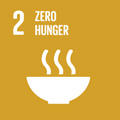- Docente: Andrea Gianotti
- Credits: 6
- SSD: AGR/16
- Language: Italian
- Teaching Mode: Traditional lectures
- Campus: Cesena
- Corso: First cycle degree programme (L) in Food Technology (cod. 8528)
-
from Feb 17, 2025 to May 21, 2025
Learning outcomes
The main outcome is the knowledge of the chemical, physical and biological factors that influence the development and survival of pathogenic and profitable microorganisms. This knowledge is necessary to understand the role of microorganisms in food. The student will be able to identify and predict the effect of formulation and technological processes on the microbial quality and food safety.
Course contents
- Role of pathogenic and profitable microorganisms in food.
Microorganisms and food quality: impact of microorganisms on hygienic safety, nutritional and sensory impact
Food pathogens and spoilage bacteria and their effect on the
management of food quality Growth of microorganisms: optimal
conditions, stress conditions. Growth kinetics of death and types
of factors that influence the development / death. The microbial
ecology applied to foods.
- Factors affecting the development and survival of microorganisms
in food.
Intrinsic factors: pH, water activity, potential redox, microstructure, nutrient antimicrobial compounds.
Extrinsic factors: temperature, humidity, gas composition in the headspace, microbial interactions.
Contamination of surfaces: factors determining adhesion and
biofilm formation
- The control of microorganisms or physical treatments, physical
and biological agents: Use of temperature, pressure, ionizing
radiation, gas mixtures, synthetic and natural antimicrobial
substances, microbial protective cultures. Combined treatments:
combined effect of technological treatments on survival and growth
of microorganisms.
- Contamination control, development and survival in foods or Main
microbial groups in food: Pseudomonadaceae, Acetic acid bacteria,
Enterobacteriaceae (Coliforms, E.coli), Micrococcaceae, Lactic acid
bacteria, bifidobacteria, propionic acid bacteria, Bacillaceae,
Clostridia, Yeasts, molds.
Risk factors in the food ecosystem: Influence of formulation,
process and distribution of the contamination, the development and
survival microbial microflora associated with specific foods.
Control of fermentation processes: application of the concepts of
microbial ecology for the optimization of fermentation
processes.
Assessment and quantification of the risk and control strategies
of quality and microbiological safety exercises in the laboratory
or in the classroom of some case studies (working project),
seminars on development and management of quality and
microbiological safety of food, HACCP, MRA ( Microbial Risk
Assessment).
- Exercises in class for the application of knowledge to case
studies related to major food sectors
- Technical guided tours in food companies
Readings/Bibliography
B. Ray 2003 Fundamental Food Microbiology CRC Press
Giovanni Antonio Farris, Marco Gobbetti, Erasmo Neviani, Massimo
Vincenzini Microbiologia dei prodotti alimentari (2012) Casa
Editrice Ambrosiana ISBN: 978-88-08-18246
Luca Cocolin Marco Gobbetti Erasmo Neviani. Microbiologia alimentare applicata. Casa Editrice Ambrosiana. Distribuzione esclusiva Zanichelli; 2022.
Lecture notes provided during the lessons
Teaching methods
Lectures, seminars, educational visits to food companies and analysis of case studies
Assessment methods
Verification of learning is done through an oral exam. The exam
consists generally of three questions to ascertain the basic
knowledge of the factors affecting the microbial ecology and their
application in the ecosystems of the main food sectors.
The mark for the integrated course of "Food Microbiology" is
calculated as the arithmetic average of the marks of the courses of
"Food Microbiology" and "Industrial Microbiology".
Teaching tools
Videoprojector, PC, slides
Links to further information
https://www.researchgate.net/profile/Andrea_Gianotti
Office hours
See the website of Andrea Gianotti
SDGs



This teaching activity contributes to the achievement of the Sustainable Development Goals of the UN 2030 Agenda.
